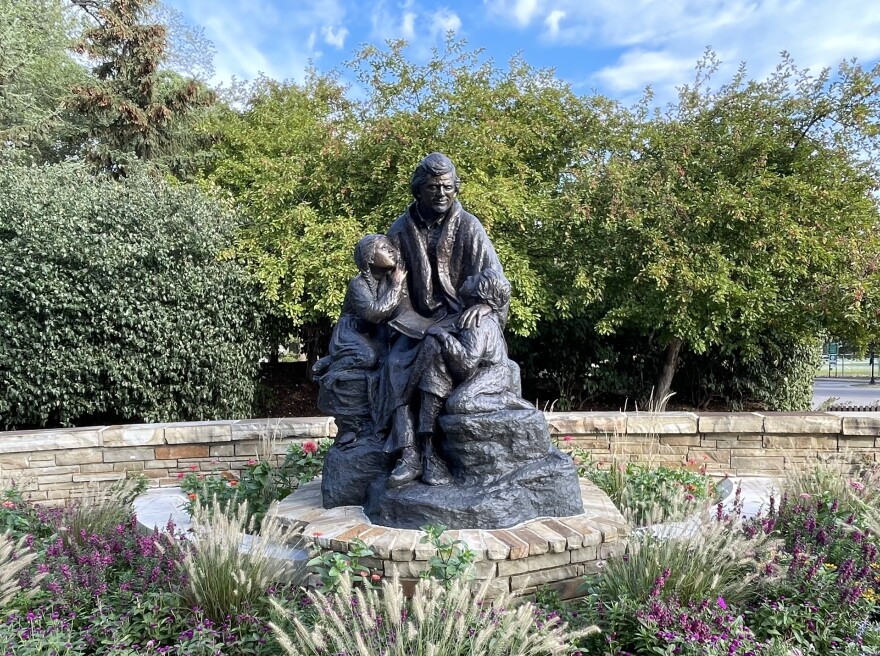This story was first published in KCUR's Adventure newsletter. You can sign up to receive stories like this in your inbox every Tuesday.
Shawnee is named for the Shawnee Tribe, an Eastern woodlands tribe that was forced to relocate to a 1.6-million-acre reservation in eastern Kansas in the 1820s and ‘30s. All of what became Johnson County, and more, was part of the reservation.
The Shawnee Tribe started the farming community that would eventually define Shawnee in the early 20th century and spark its growth.
White settlers began to move into the area in 1854 and Shawneetown was incorporated in 1856. Though the Shawnee Tribe was later forced to move again, their influence in the area remained.
Over the next 150 years, the town of Shawnee grew from a 1-mile-wide settlement to one of the largest cities in Kansas by annexing neighboring towns all the way to the Kansas River, its western border, by 1999.
Now the city is a mix of quiet neighborhoods and busy commercial corridors, with Shawnee Mission Parkway and Interstate 435 connecting it with Kansas City, Missouri, and the larger metropolitan area.
Traces of the Past

The area, at first more of a camp spot, was originally named Gum Springs. The city honors the name with Gum Springs Park on 67th Street, east of Quivira Road, though the park is currently closed due to extensive renovations.
Gum Springs was the site of Kansas’ first Territorial Governor’s Mansion. Built in the 1850s, it is one of the oldest buildings in Kansas. (The oldest building in the state is also nearby: Fangro House was built around 1824 and is now part of the Calkins Electric Supply Co, Inc. complex.)
There are traces of the past in historic buildings and sites downtown and throughout the city. You can take a walking or driving tour that marks many of these sites. You can also learn about other towns and settlements in the western part of Shawnee through the Monticello Community Historical Society, which has a driving tour featured in KCUR’s Ghost Towns Adventure.
When the Shawnee Tribe came to the area, they requested a missionary from the Methodist Church, and Thomas Johnson, for whom Johnson Drive and Johnson County are named, came to Kansas to establish three missions in the area. Three buildings remain on the Shawnee Indian Mission State Historical Site in Fairway, Kansas, a National Historic Landmark.
The Shawnee Indian Cemetery is tucked into a quiet neighborhood in Shawnee, just off Nieman Road. That and a small natural spring are nearly all that is left of Gum Springs. Burials took place in the cemetery from 1837 to 1870. The headstone for Chief Joseph Parks, the first elected chief of the Shawnee, is one of the few grave markers remaining. In 2022, Kansas Gov. Laura Kelly transferred ownership of the property from the Kansas Historical Society to the Shawnee Tribe.
Chief Charles Bluejacket, a farmer and Methodist minister, was selected leader of the Shawnee Tribe in 1861. He’s honored with a Bluejacket Avenue, where the cemetery is located, the Bluejacket/Flint Elementary School, and a life-sized monument in Herman E. Laird Park, previously called Blue Jacket Park. Bluejacket left Kansas in 1871, when the Shawnee were forced to move again, and established the town of Bluejacket, Oklahoma.
From settlement to city

Frontier trails like the California Road, Fort Leavenworth Military Road, Gum Springs Route, Santa Fe Trail, and Westport Route crisscrossed the area of Shawnee, bringing people to and through the region. A testament to these travelers stands along Shawnee Mission Parkway in Pioneer Crossing Park, with sculptures of a wagon train by Charles Goslin, historical markers and native grasses.
Shawnee City Hall stands where the town’s original public square used to be, at Nieman Road and Johnson Drive (formerly Main Street) — then a gathering place with a gazebo bandstand. Inside, you can see murals by Goslin depicting Shawnee history, including a collage of flowers representing the many peoples who have lived in Shawnee and impacted its legacy.
Before William Clarke Quantrill’s raid on Lawrence, the Southern sympathizer and his band of guerillas set fire to Shawneetown and killed two men in 1862. A plaque near City Hall commemorates the violence that nearly destroyed the young town.
The area grew in the early 20th century, with small truck farms supplying produce and goods to Kansas City. You can see a replica truck farm, town square, and gazebo at Shawnee Town 1929, located in Herman E. Laird Park just west of City Hall.
The site offers self-guided and docent-led walking tours (though you should call ahead for the docent tours, as they also have many field trips) and community events, such as the summer series Jammin’ on the Green, the upcoming Historical Hauntings in October, and In Their Footsteps, a Lantern Walking Tour in November.
Throughout the 20th century, Shawnee grew to encompass more than 42 square miles and nearly 69,000 residents. It’s also home to the Hindu Temple and Cultural Center of Kansas City, a reflection of the city’s changing demographics.
City center

Just across the street from City Hall is a row of historic buildings that includes the stone 1909 Shawnee State Savings Bank, now housing District Pour House + Kitchen, which opened in this location in May 2023. You’ll also see the vibrant pink facade and neon marquee of the 1927 Aztec Shawnee Theater, originally Mission Theater, recently renovated and reopened, which hosts movies and live performances.
As a nearby mural reads: “This is where fun happens.” There are three breweries within a two-block radius of City Hall: Friction Brew Co., Transport Brewery, and Servaes Brewery Company — the first in Kansas owned and operated by a female head brewer. You’ll also find cafes, eateries, and specialty shops, along with craft cocktail bars. Drastic Measures was a James Beard Award finalist, and its neighbor Wild Child is NA-friendly.
Shawnee has community events throughout the year, with Third Thursday Moonlight Markets and Farmers’ Market on Saturday mornings at City Hall, May through October. Yearly events include the St. Patrick’s Day Parade in March, Old Shawnee Days in June, Great Grillers in September, and the upcoming Scarecrow Festival, a children’s craft festival on Oct. 7, from 9-11:30 a.m., when the downtown area is transformed with autumnal splendor.
The oldest restaurant is Old Shawnee Pizza, established in 1969. Enjoy its cracker-crust pizza in a dining room studded with historic images. Shawnee has a variety of independent restaurants, with fun options like Fritz’s Railroad Restaurant, where burgers are delivered via miniature train system, and Pizza West, with lunch and dinner pizza buffet and pinball machines.
Caenen Castle, built in 1905, is now home to Wandering Vine, a fine-dining establishment in one of Johnson County’s most iconic buildings. Read about it in KCUR’s Local Castles Adventure.
Further west on Johnson Drive, the Shawnee Civic Center hosts events like the annual KidsFest Business Fair for young entrepreneurs in September and the Holiday Treasures Craft Market on Oct. 28.
Parks and playtime

There’s plenty to do in Shawnee throughout the year and, when the weather’s good, it’s got plenty of green space to explore, including Shawnee Mission Park, the largest park in Johnson County.
Shawnee has three Sister Cities and four parks to honor those relationships, including the Sister Cities Park, Listowel Park (for Listowel, Ireland), West Flanders Park (for Pittem, Belgium), and Erfurt Park (for Erfurt, Germany).
Throughout the late 1800s and into the 20th century, immigrants from Belgium, Ireland and Germany came to the area. In West Flanders Park, the play structure is shaped like a castle, and there is a plaque and garden to commemorate those lost in WWI. At Erfurt Park, the pavilion reflects German-style architecture.
Parks also honor some of the former communities within the city limits, like Wilder Bluff Park near the western side of the city, with its tree canopy play structures, and Monticello Springs Park near Highway 7.
During the summer months, you can cool off at the downtown Splash Cove or Soetaert Aquatic Center, which hosts an annual Dive In Movie (bring an inflatable for your viewing experience) in July.
If you’ve played softball or baseball locally, chances are you had a game out at the Mid-America Sports Complex or Mid-America West Sports Complex, on the western end of Johnson Drive. Nearby, enjoy volleyball at the Shawnee Mission Beach Volleyball club March through October.
There’s also year-round skating lessons, hockey, public skate and freestyle sessions at the KC Ice Center. In the winter, they open the Holiday Pavilion for outdoor skating.
Mill Creek Streamway Park runs from the Kansas River south through Johnson County for 17 miles, connecting Shawnee, Lenexa and Olathe. The trail’s northern terminus is across a footbridge to Nelson Island, off of Wilder Road, which can be an excellent place to spot bald eagles during the winter season.







